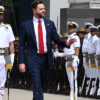This week marks the one year anniversary of the president’s election to commander chief, but it seems more like an occasion for concern than for slapping high-fives.
It is not hard to craft comparisons between Carter and the current occupant of the Oval Office. Both entered office with high expectations; both vowed to change the tone in Washington and remake the world. Carter had a terrible sophomore slump. America’s enemies took stock of his foreign policy in his first year in office. The next year they exploited the weaknesses they found. His presidency never recovered. Obama may also be setting himself up for the fall.
In many ways, Obama has mimicked Carter’s foreign policy priorities. The most noticeable Carter-like act from the White House is gutting defense. Faced with a poor economy and a post-Vietnam distaste for military power, Carter took a “peace dividend” that left the military hollow. He disguised his defense by arguing he was transforming the military with a new strategy. That certainly did not fool the Russians, who took American retrenchment as a sign to step up aggression from South Asia to Africa to the doorsteps of the US in Latin America.
The Daily Signal depends on the support of readers like you. Donate now
Obama is trying a similar strategy. Heritage defense analyst Baker Spring rightly argues that the administration’s long-term plans for the Pentagon are a train wreck just waiting to happen. Even our allies see this one coming. Recently, Australia produced its new defense blueprint and pushed through a surge in defense spending, predicted largely on the belief that they could not longer count on the America as a resolute defense partner in the years ahead.
The president has also opted on the old tried-and-totally unproven strategy of arms control “uber alles.” He has subordinated virtually every defense and foreign policy priority to signing new treaties limiting strategic weapons. Most damaging, he has started to gut the missile defense programs that would protect the nation and its allies from attack. While the White House has denied they are taking large backward steps, Heritage analysis finds otherwise. Indeed, it is likely that the administration’s course on arms control may result in more states owning nuclear weapons and the missiles that carry them.
On the foreign policy front, the administration’s “soft power” strategy that relies almost exclusively on negotiations and international institutions like the UN has little to show for it—other than how other nations can manipulate the White House dependence on diplomacy. Most striking has been the US bartering with Iran that has failed to produce any practical result. As Heritage Middle East expert Jim Phillips has pointed out time and time again, the Iranians use these negotiations to their own ends. Additionally, even if the US did get an agreement it would probably mean little. Iran, he notes, “probably still has nuclear chess pieces hidden under the table that it will reveal triumphantly at the end of the game. At that point, with a nuclear weapon in hand, Tehran will declare checkmate – or in Farsi: “shah mat” (“the king is ambushed” or “helpless”).”
Finally, and perhaps of greatest concern, is that the administration has shown little understanding that it knows how to use “hard power.” Almost a year after the president took office he still can’t seem to decide on an appropriate strategy for Afghanistan.
When our enemies look at the US they see a president soft on hard power and hard over on doing whatever it takes to make soft power look smart. How they choose to use this knowledge may make the second anniversary of the president’s election much less of a cause for celebration.






























